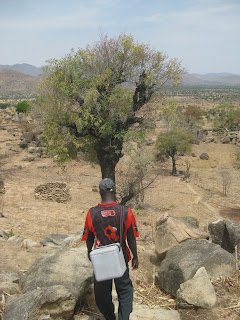
Continuing the French lessons, this literally means, “White people do things!” and was the theme of my most recent conversations with Jacques, mostly regarding a number of technologies that have been developed to facilitate health care in alternatively-resourced settings such as rural Cameroon. We were discussing vaccine vial monitors, small squares stuck onto all vaccines which portray a purple circle surrounding a white square to indicate that the vaccine has not been exposed to temperatures which would render it useless during its travels from the laboratory to the rural heath worker's cooler. In the event that a vaccine has been allowed to get too hot and therefore become ineffective, the white square turns dark purple. It is a pretty great technology. another technology that impressed Jacques are the auto-disable syringes whose plungers cannot be retracted after being used once, thereby making it impossible to use the same needle to inject multiple people. The whole conversation started when Jacques was putting together a safety box for the disposal of used syringes and other medical materials. The box starts as a flat piece of cardboard and after following 7 steps of folding and punching out pieces it becomes a free-standing rectangular box complete with a handle and an opening with a sliding cover for inserting the used materials. The most recent development to come our way shows further how the manufacturers of these products recognize the realities of the health care workers who use these items everyday to save lives at the village level. The new pentavalent DTPw-Hib vaccine, which comes in the form a solvent which must be mixed with the vaccine solute before administration of the vaccine, comes in vials containing 2 doses of vaccine each. The advance here is that many of our rural vaccine posts only attract 5-10 children for each monthly visit, and since vaccines which must be mixed prior to administration, like the Hib, lose their efficacy between 10-12 hours after mixing, I've seen health workers decide not to vaccinate kids directly on schedule with these vaccines because to vaccinate 2 children they will then lose 18 doses of a vaccine such as BCG, which comes in a 20 dose vial.
All this equipment may seem rudimentary from the standpoint of the American system of medical care, but the difference it makes out here in the villages of Cameroon is hard to exaggerate. When studying such advances in school, I acknowledged these as neat and creative solutions to some significant technical problems with delivering health care in developing countries, but to actually see them at work is to understand that it is nearly impossible to exaggerate the difference they make. In a place where electricity, if it exists, is sporadic at best, vaccine vial monitors literally save thousands of lives that would be lost to vaccine-preventable diseases otherwise. For people whose manner of existence depends on the nearly infinite recycling of almost every possession, where children routinely scavenge things from piles of trash to use as material for toys, auto-disable syringes and safety boxes prevent many injuries as well as illnesses. So whether it's accurate to claim that it is the 'white people' doing these things or not, the impact is not lost on the rural health workers whose daily lives these advances impact profoundly.

2 comments:
As always, I enjoyed reading your latest blog post. What you wrote about the safety syringes reminded me of my own experience with safety syringes at the hospital I volunteered at in Tanzania. For the most part, they had no safety needles and would just throw their used needles away in the regular trash. The one exception was the insulin needles, which were the same as insulin needles here in the US and had the orange safety lock on the end to prevent needle sticks. Well, one of the local nurses had never heard of such a thing, and pulled the safety lock OFF before drawing up the insulin and giving her shot. It struck me because I use these safety needles every day and it's just become second nature to me to have them.
Anyhow, I hope that you are loving life in Cameroon and I look forward to reading your next entry.
Love from Boston,
Kristen
Hey Katie,
Welcome to my world!!! I bet being in the audience just watching was more fun for you than for the teacher. The pride at the end of the school year though is the special payoff for the teacher. I really smiled and pictured the whole ceremony as I was reading your blog. Yes, some kids' behaviors are indeed universal. Thanks for making me smile! Love you lots, Mom
Post a Comment